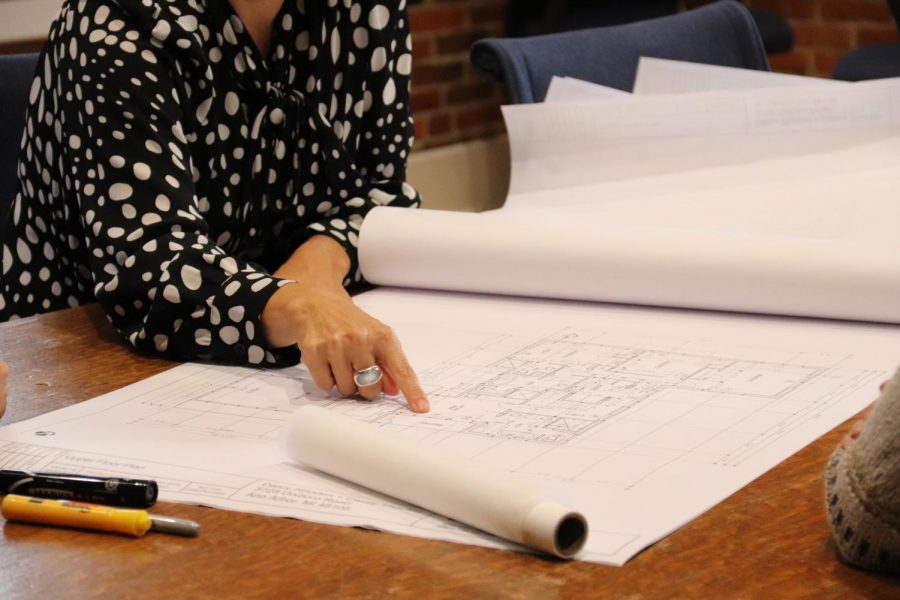Women in Architecture
Architecture has been a part of Jen Hinesman, Melissa Kennedy and Rebecca Lussier’s lives for several years.
Lussier’s father was a contractor, which allowed her to visit job sites with her father. When she was in eighth grade, her house tripled in size with an addition. She remembers following the crew around, asking countless questions.
“I actually grew up in this industry, and I’m comfortable in it,” she said.
Lussier went to college for interior design, but was required to take classes in construction. She was one of three women in the construction classes, unlike in her design classes, where there were more women than men.
“In the construction classes, there were definitely some of those guys who were like ‘step aside, women’,” Lussier said.
Like Lussier, Hinesman grew up loving interior design. She was continuously finding new ways to switch up her room.
“I was constantly rearranging furniture, and my mom was always very supportive of me,” Hinesman said. “It was my own mess and my way of expressing creativity.”
After going to college for interior design, Hinesman moved to Frankfurt, Germany and was able to talk her way into a marketing position at Deutsche Bank. She spent two years working as a marketing coordinator, but realized that she couldn’t do any random job and feel fulfilled.
“It taught me that I needed a profession that really fed me,” Hinesman said. “I’m a creative person and if I don’t have a creative outlet, it feels like the creativity just eats away at you.”
Hinesman made the decision to attend graduate school at the University of Michigan. She earned a master’s degree in architecture to help broaden her understanding of architecture and design.
“It was something I did for myself because I felt like I needed to further my education,” Hinesman said.
As a student in high school, Kennedy was a part of a marketing extracurricular, DECA, that prepared emerging leaders and entrepreneurs in marketing, finance and management.
“I have always been curious about male dominated fields,” Kennedy said. “But now that I think about it, that curiosity always existed in my subconscious.”
When Kennedy began college at University of Michigan, she was excited because while there weren’t that many women in architecture, the industry was clearly changing.
“If you have the viewpoint that you’re going against the grain, you will see how hard it is,” Kennedy said. “I think my outlook has been more of what an opportunity there is for a female to influence this profession, instead of who’s out to get me.”
Although the industry is changing, women in architecture still experience discrimination and sexism. Even if the discrimination is mild, it still has an influence on the industry.
“I feel that I have had to work harder to prove myself and show that I have the same amount of capability, if not more, than a man, to do this job and do it well.” Hinesman said.
Lussier recalls being referred to as “the girl in the office” on countless occasions. The comment may seem meaningless, but has such an impact on the women in the industry that they have even started referring to themselves as “the girl in the office”.
“Most of the time they’re joking around, but then they realize you’re standing there and they’re like, oh this doesn’t pertain to everyone here, ” Lussier said. “Sometimes they care and sometimes they don’t.”
Kennedy had been working at Meadowlark, a design/build company, for about two years running the design team. She was meeting with a project manager for the first time when he assumed her role due to her gender.
“The first thing he said to me was, ‘Oh, do you answer the phones?’” Kennedy said, “I answered yes, because I wasn’t gonna sit here and try to prove myself, so I chose to not be offended.”
Hinesman and her coworker had a similar experience when they showed up at a homeowners house to begin discussing a new project. When they entered the house, they realized the look on his face was pure disappointment.
“We proved him wrong, and it ended up being a beautiful project.” Hinesman said.
There have been many changes of the past couple of decades revolving around women in architecture. Hinesman, Kennedy, and Lussier have all met women who are very strong in the architecture realm, and serve as role models for them and other young women. It’s still rare to find a woman doing physical labor, but there are now a lot of women in management.
“The world is changing and the way you perceive it is a big thing,” Hinesman said. “There are no male and female professions, and that line is becoming more and more blurred as the next generations come into the workforce.”
There used to be a handful of female employees at Meadowlark, but women now make up 70% of the company.
“I think women in a profession attract other women.” Kennedy said.
It may not stand out to female architects that what they do in their industry on a daily basis is anything amazing or different, but they are creating vision for younger women aspiring to have a career in architecture.
“It’s all about your knowledge and where you’re going to apply yourself, it shouldn’t matter if you identify as a man or a woman,” Lussier said. “As long as you respect yourself and acknowledge the struggles, but still stand firm, you can do just about anything.”





